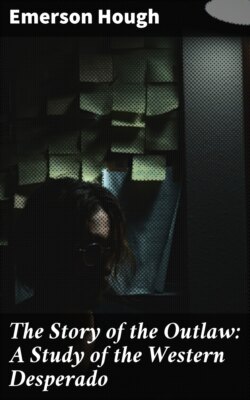The Story of the Outlaw: A Study of the Western Desperado

Реклама. ООО «ЛитРес», ИНН: 7719571260.
Оглавление
Emerson Hough. The Story of the Outlaw: A Study of the Western Desperado
The Story of the Outlaw: A Study of the Western Desperado
Table of Contents
PREFACE
ILLUSTRATIONS
Chapter I
Chapter II
Chapter III
Chapter IV
Chapter V
Chapter VI
Chapter VII
Chapter VIII
Chapter IX
Chapter X
Chapter XI
Chapter XII
Chapter XIII
Chapter XIV
Chapter XV
Chapter XVI
Chapter XVII
Chapter XVIII
Chapter XIX
Chapter XX
Chapter XXI
Chapter XXII
THE END. FOOTNOTES
Отрывок из книги
Emerson Hough
Published by Good Press, 2019
.....
That there were grades in counterfeit bad men was accepted as a truth on the frontier. A man might be known as dangerous, as a murderer at heart, and yet be despised. The imitation bad man discovered that it is comparatively easy to terrify a good part of the population of a community. Sometimes a base imitation of a desperado is exalted in the public eye as the real article. A few years ago four misled hoodlums of Chicago held up a street-car barn, killed two men, stole a sum of money, killed a policeman and another man, and took refuge in a dugout in the sand hills below the city, comporting themselves according to the most accepted dime-novel standards. Clumsily arrested by one hundred men or so, instead of being tidily killed by three or four, as would have been the case on the frontier, they were put in jail, given columns of newspaper notice, and worshiped by large crowds of maudlin individuals. These men probably died in the belief that they were "bad." They were not bad men, but imitations, counterfeit, and, indeed, nothing more than cheap and dirty little murderers.
Of course, we all feel able to detect the mere notoriety hunter, who poses about in cheap pretentiousness; but now and then in the West there turned up something more difficult to understand. Perhaps the most typical case of imitation bad man ever known, at least in the Southwest, was Bob Ollinger, who was killed by Billy the Kid in 1881, when the latter escaped from jail at Lincoln, New Mexico. That Ollinger was a killer had been proved beyond the possibility of a doubt. He had no respect for human life, and those who knew him best knew that he was a murderer at heart. His reputation was gained otherwise than through the severe test of an "even break." Some say that he killed Chavez, a Mexican, as he offered his own hand in greeting. He killed another man, Hill, in a similarly treacherous way. Later, when, as a peace officer, he was with a deputy, Pierce, serving a warrant on one Jones, he pulled his gun and, without need or provocation, shot Jones through. The same bullet, passing through Jones's body, struck Pierce in the leg and left him a cripple for life. Again, Ollinger was out as a deputy with a noted sheriff in pursuit of a Mexican criminal, who had taken refuge in a ditch. Ollinger wanted only to get into a position where he could shoot the man, but his superior officer crawled alone up the ditch, and, rising suddenly, covered his man and ordered him to surrender. The Mexican threw down his gun and said that he would surrender to the sheriff, but that he was sure Ollinger would kill him. This fear was justified. "When I brought out the man," said the sheriff, "Ollinger came up on the run, with his cocked six-shooter in his hand. His long hair was flying behind him as he ran, and I never in my life saw so devilish a look on any human being's face. He simply wanted to shoot that Mexican, and he chased him around me until I had to tell him I would kill him if he did not stop." "Ollinger was a born murderer at heart," the sheriff added later. "I never slept out with him that I did not watch him. After I had more of a reputation, I think Ollinger would have been glad to kill me for the notoriety of it. I never gave him a chance to shoot me in the back or when I was asleep. Of course, you will understand that we had to use for deputies such material as we could get."
.....